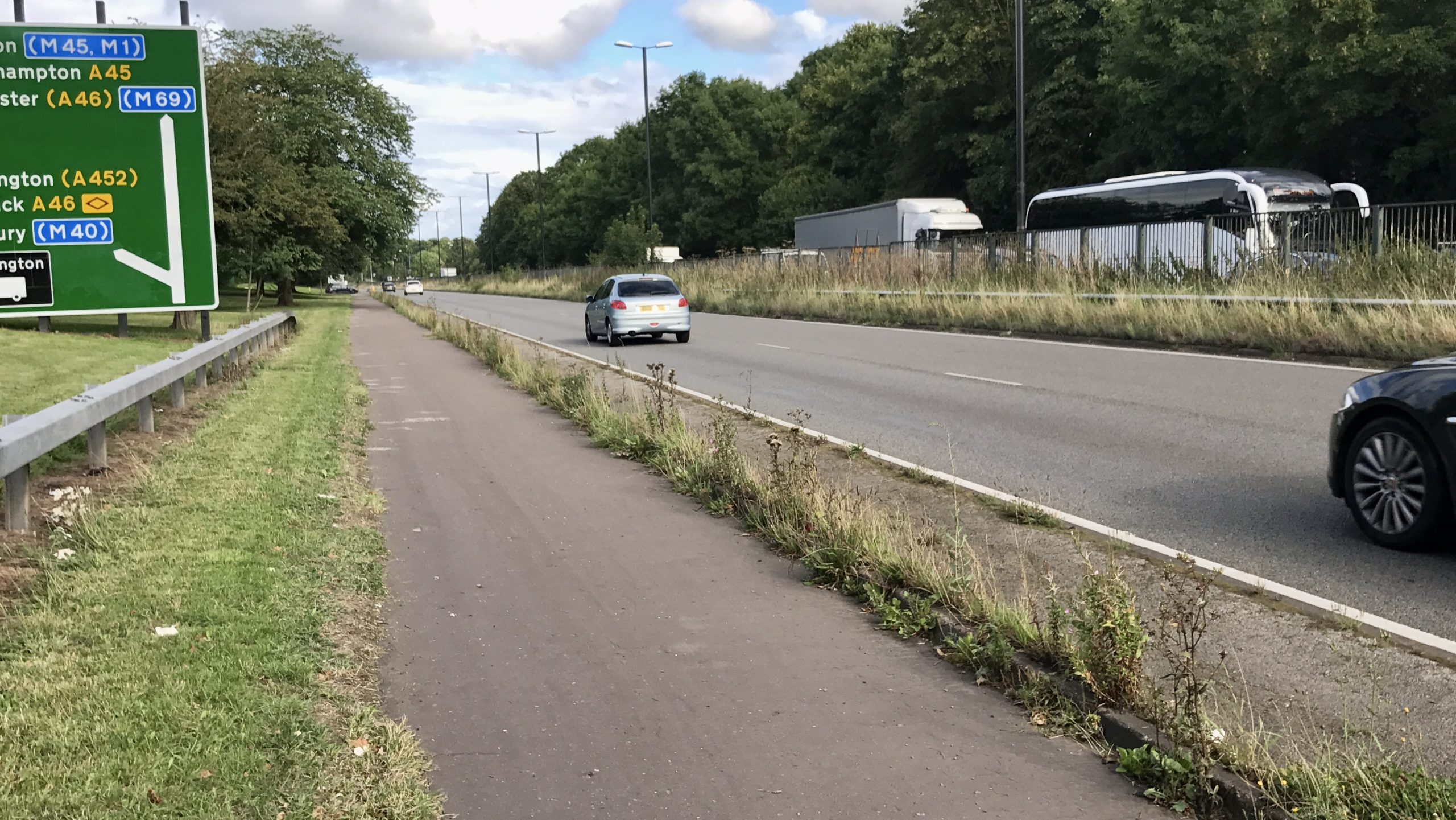
Kenpas Highway looking towards Baginton, 1943. Credit: Coventry Archives.
A 1930 Act of Parliament empowered the “Mayor, Aldermen, and Citizens of the city of Coventry to acquire lands and construct street works and a bye-pass road.” Land along the route of the planned Coventry bypass was “sterilised,” preventing any development but, remarked an Alderman in 1935, the road was “held up … for various reasons, including the financial crisis and the fact that the Ministry of Transport could not make up its mind about the width.”
Nearly seven miles long, the bypass — consisting of the Dunchurch, Fletchampstead, Kenpas, and Stonebridge highways — was built in stages with some pre-1934, 80-ft-wide sections widened soon after they were built. This was to satisfy the Ministry of Transport’s Spring 1934 desire for dual carriageways to sport cycle tracks.
The bypass “will commence at the Toll Bar, Willenhall, and finish on the Birmingham side of Allesley village,” reported the Coventry Evening Telegraph.

Plan: “Proposed Coventry bypass, 2nd Dec 1935 John Mowlem & Co Ltd for E.H. Ford, City Engineer, Coventry.” The proposed cycle tracks are coloured purple. Credit: Coventry Archives.
“From Willenhall it will skirt Whitley aerodrome, join up with the Kenpas Highway at Green Lane, cross the Kenilworth main road there, continue along the partly-finished Fletchampstead Highway, pass close to the Hearsall golf course, and on to the Standard Works at Canley. There it will cross the Birmingham railway, over Tile Hill Lane and Broad Lane (this section is now in being), and then go on over open country to its termination beyond Allesley.”
The newspaper added: “Approximately one mile of the new road is finished in three sections, but these are constructed under the original scheme providing for a single carriageway only. Since the road was held up by the financial crisis some new ideas have been introduced, including a double carriage track (after the style of that now in being on the London Road), and also 10-foot cyclists’ paths on each side.”

Some sections of the period cycle tracks on Coventry bypass remain in good condition.
Some stretches of these cycle tracks — which are actually 9-ft-wide — are today well preserved and still in use; others lie beneath encroaching vegetation, unused, leading from nowhere to nowhere; some parts have been lost under later junctions. The cycle tracks beside the Coventry bypass linked with the cycle tracks beside the Kenilworth Road.
The addition of the cycle tracks was at the insistence of the Ministry of Transport which, early in 1934, commissioned the building of experimental cycle tracks on London’s Western Avenue.
Beneath the sub-head “Roads for cyclists” the Coventry Evening Telegraph reported that “the Ministry desire that, in the length of the road remaining to be constructed, there be provided (a) dual carriage-ways, and (b) cycle tracks, and they ask for the plans … to be amended accordingly.”
Coventry Corporation agreed to the imposition — which required a 100-ft-wide road compared to the 80-ft-wide road in the 1930 plan — provided the MoT would give an “assurance of a 75 per cent. grant towards the actual cost.”

Period sign for the Coventry By-Pass Road.
A tender for the contract to build the new stretches of road was advertised in December 1934, with John Mowlem & Co. submitting the winning bid.
“In 1935, when it was felt that the project to complete the road might once more be advanced, new Parliamentary powers had to be obtained owing to the acceptance by the City Council, and the Ministry, of the idea of dual cycle tracks and service roads, involving nearly double width for the construction of the road which had been obtained the previous Act,” remembered Coventry’s city engineer Ernest Hone Ford in 1940, when the bypass was fully opened.
The nearly seven-mile road was surfaced with either concrete or asphalte macadam, and the cycle tracks “were constructed in tarred limestone, except at road junctions, where an apron concrete was laid in order show up the entrance to the cycle track,” said Ford, who had been the city’s chief engineer since 1924.

Use of the MoT’s in-house font on in situ signs still to be found on or close to the Coventry bypass. The font is a revised version of an all-caps black alphabet on a white background first used in 1921 for fingerpost direction signs.
“Precast concrete kerbing 10 inch by 2 inch borders the tracks,” he added.
“When the by-pass is completed early in 1938, Coventry will be able to take pride in possessing one of the finest and most modern roads in the country,” reported the Coventry Evening Telegraph in March 1935. It would have “wide footpaths, service roads, cycle tracks, and twin carriage ways, and extending for over seven miles between Willenhall and the further side of Allesley.”
Describing such multi-featured roads as “ultramodern” a Coventry Evening Telegraph columnist wrote in July 1934 that the MoT insisted “upon special paths for cyclists.”

Some parts of the Coventry bypass cycle tracks are overgrown and little used because of later junctions.
“It would be far safer for the pedal cyclist, and for the motorist, if special cycling tracks existed alongside all main roads,” argued the columnist.
“I do not know how it is proposed to legislate for their use; one assumes that the use of these special tracks will be optional, for I can foresee many knotty problems ahead if the cyclist is prohibited from using the main road. At all events, Coventry’s new by-pass road will almost certainly be constructed with such special cycling paths, while the City Engineer (Mr. E. H. Ford) has now been requested to report to the appropriate committee concerning other roads in the city where he considers the construction of such tracks for cyclists would be appropriate.”






